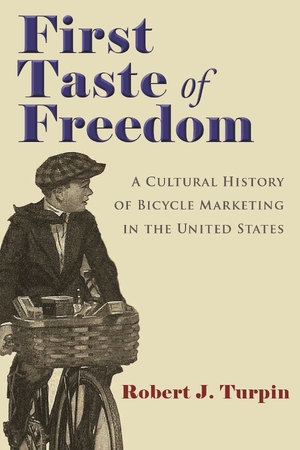"An interesting addition to the growing bibliography of books connected to various aspects of the bicycle in American society."—idrottsforum.org
"In First Taste of Freedom Robert J. Turpin mounts a convincing argument that the history of bicycle marketing can illuminate the cultural history of the United States."—The Journal of American History
"This book is not only an account of the supply and demand of the American bicycle industry but also a mirror reflecting the social changes that shaped the industry and the cultural mood that colored its various stages. The interdisciplinary perspective, rich detail, and insightful summary boost the value of this book."—Journal of Sport Management
"Turpin examines the vehicles ever-changing image and significance, the way that Americans' attitudes toward bicycles and cycling changed, and how manufacturers built upon these transformations (and aided in their creation) with their marketing and sales campaigns."—Alon K. Raab, Journal of Sport History
"Turpin’s work is a valuable correction in the subfield of cycling history, and likewise would be a useful read for all those interested in twentieth-century America generally, more specifically in American masculinity, car culture, advertisements and marketing."—Sport in History
"Robert Turpin’s compelling new book delves into the twentieth-century transformation of bicycles from adult leisure object to children’s toy. Business, consumer, and bicycle historians will welcome this remarkable book."—Thomas Burr, Associate Professor, Illinois State University
"Turpin takes a broad view of the bicycle’s changing forms and significance throughout its 200-year history and spins an engaging tale of marketing, manhood, and unintended consequences."—Margaret Guroff, author of The Mechanical Horse: How the Bicycle Reshaped American Life
Description
The bicycle has long been a part of American culture but few would describe it as an essential element of American identity in the same way that it is fundamental to European and Asian cultures. Instead, American culture has had a more turbulent relationship with the bicycle. First introduced in the United States in the 1830s, the bicycle reached its height of popularity in the 1890s as it evolved to become a popular form of locomotion for adults. Two decades later, ridership in the United States collapsed. As automobile consumption grew, bicycles were seen as backward and unbecoming—particularly for the white middle class.
Turpin chronicles the story of how the bicycle’s image changed dramatically, shedding light on how American consumer patterns are shaped over time. Turpin identifies the creation and development of childhood consumerism as a key factor in the bicycle’s evolution. In an attempt to resurrect dwindling sales, sports marketers reimagined the bicycle as a child’s toy. By the 1950s, it had been firmly established as a symbol of boyhood adolescence, further accelerating the declining number of adult consumers.
Tracing the ways in which cycling suffered such a loss in popularity among adults is fundamental to understanding why the United States would be considered a “car” culture from the 1950s to today. As a lens for viewing American history, the story of the bicycle deepens our understanding of our national culture and the forces that influence it.
Table of Contents
Introduction: Conceptions of Bicycles
1. Cycling’s Rise and American Manhood
2. Automobiles and a World at War
3. Cooperation and Confusion
4. The Child Consumer
5. The Postwar Slump
6. The Safety of Cycling
7. Surviving the Great Depression
8. Bicycles in the Age of Affluence
9. High-Risers and Multi-Geared Redeemers
Conclusion: Consumers as Derailleurs
About the Author
Robert J. Turpin is assistant professor of history at Lees-McRae College in North Carolina.
June 2018

